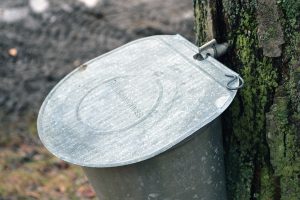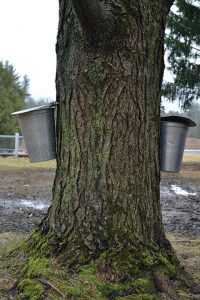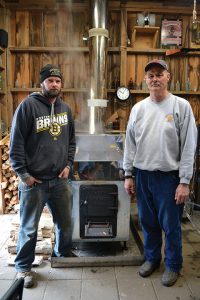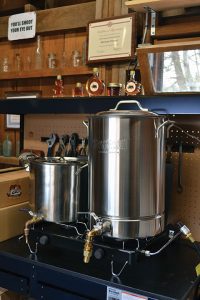Just off Mattapoisett Road tucked in a corner behind some trees is a small, wooden shack billowing steam from an open skylight window. It’s an early late-winter morning – the time of year when warmer, more temperate days now dawn but still slip back into cold, subfreezing nights.
At Mike Forand’s house, these milder mornings are melting the earth beneath the surface, as evidenced by the wide tire tracks of mud that crisscross his yard. Beneath the ground things are stirring; roots are awakening. It’s the perfect weather pattern – warm days, cold nights – for Forand to tune in to nature, tap into tradition, and collect every last drop of early spring as it encroaches.
For just over a week now leading up to that Wednesday morning on February 21, Forand has been up and at it almost every morning at 6:30, going from maple tree to maple tree in his yard and at other locations around Rochester and Acushnet lifting the lids off of metal buckets fastened to the sides of the trees to see how much liquid has collected inside. He pours that clear watery liquid into larger buckets and takes them back home to that wooden shack. Before long, that ordinary shack is transformed into a “sugar shack” where the stuff of pancake and waffle dreams are made.
Forand has been making his own maple syrup for decades since he was a kid. His father designed and created his own system for filtering and boiling the clear, watery, sugary sap until it thickened and browned and condensed into what you pour all over your pancakes.
“It would take forever,” said Forand. “It was strictly for fun,” he added, since back in the day Forand’s dad’s operation would produce only a fraction of what Forand can process today.
Making maple syrup, however time consuming it was when he was a kid, is still a lengthy process. The sap itself is only about one percent sugar and 99 percent water. Forty gallons of sap will yield just one gallon of syrup!
The inside of Forand’s sugar shack today looks very different from old Dad’s. Forand’s system is much more ‘sophisticated’ than the one from his childhood. There is a wood-fired boiler bubbling and steaming away right as you enter the shack. Behind it is the filtration system that runs the sap through to remove any particles and impurities. On the other side of the room is Forand’s reverse osmosis evaporator, which he’s only had for two years. The machine speeds up the boiling process considerably by reducing roughly half the water content of the sap before moving it over to be boiled.
“If I were to put the sap in the boiler without reducing it, it would easily take twelve hours,” said Forand.
It’s still an all-day activity for Forand, even with the help of his son, Tim Forand, who feeds the boiler fire about every seven minutes with split pine logs that burn up fast, but burn really hot.
The shack is a pretty sweet spot in which to pass the time. Forand’s got a small flat screen TV inside to entertain between the steps of processing the syrup. Despite the technology – the TV, the shiny metal containers, and the yards of piping and plastic tubing – the shack still has that rustic feel to it. Lining the shelves are small antique glass bottles that Forand has dug up over the years in several locations on his 42 acres of land. A sign on the wall reads “Life is better on the farm,” while another says “This farm is my happy place.” And it’s a good thing, since the Forand men will be inside that sugar shack some nights until 10:30 finishing up another day’s batch of syrup.
Forand packages the finished product into small glass jars and slaps on a sticker with the label “MRF Farms.” He may sell a few bottles at a farmer’s market here and there, but the majority of it he gives away as little gifts. His maple-sugaring season lasts about six to eight weeks, depending on the weather – those warm days and cold nights are essential for tapping. And this year, all the wet weather the region has experienced only helps those maple trees produce more sap.
“The first day on February 10, I put the drill down,” said Forand, describing what happened when he installed his first tap of the season. “The sap was flowing out of the hole it was so fast.”
The night before, Forand went outside to check on the progress of the day’s sap collection and found just ten to 12 gallons. It’s usually more like 20 to 40 gallons on any given day, Forand said, “So I knew it was slowing down.”
It might sound ‘sappy’ to say, but as Tim Forand put it: “It’s a labor of love.”
“I love it,” said Mike Forand. “I look forward to this time of year. Who else in Rochester is making maple syrup around here?”
What’s most fascinating about it, Tim added, is the fact that sugaring is totally natural. “It’s from a tree! I mean, God makes it!”
“There’s something that happens when you tap trees,” said Mike Forand. “You cannot walk by these trees without looking inside those buckets.” Even Forand’s grandchildren are drawn into the fascination of sugaring. “Once the kids get off the bus, they run over to the buckets. They want to see how much sap is in them.”
Forand’s already got cases of bottles of his homemade golden maple syrup, and there are still a few weeks left to this sugaring season. The two Forand men will spend those next few weeks doing what they do every year, what the Forand men have been doing for decades – tapping into tradition and topping the pancakes of his friends with pure Rochester maple syrup. Which begs the question: Will Tim continue the Forand tradition after he inherits the sugar shack?
“I don’t know,” he says. “We’ll see. I guess I would… Yeah, probably…”
By Jean Perry



